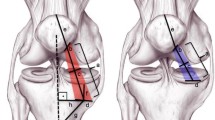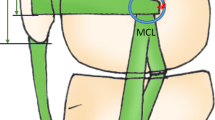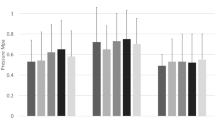Abstract
Aim of this cadaveric biomechanical study was to describe the detailed anatomy of the static medial patellar stabilizers and further determine the role of each of them in preventing lateral patellar dislocation. Eight cadaver knees, after removing the skin and subcutaneous tissues, were used in the study. The medial patellofemoral ligament (MPFL), the medial retinaculum (MR) the medial patellomeniscal ligament (MPML), and the medial patellotibial ligament (MPTL) were dissected. Their origins, insertions, orientations and sizes were recorded. To the medial stabilizers, a tension of 10 pounds was applied, using a tensiometer held in a semicircular device while the knees were kept in 30° of flexion. Then, the previously described ligaments were dissected and the resultant displacement recorded. The most anatomically distinct structure is the MPFL, whose length varies from 45–50 mm, and its width from 10–20 mm at its origin (medial femoral epicondyle) to 20–30 mm at its insertion to the patella. The “meshing” of the MPFL fibers to the fibers of the vastus medialis obliquus (VMO) close to its patellar insertion was the most interesting and very important finding. The contribution of MPFL to medial stability was more than 50%. Of the remaining ligaments, MPML contributes 24% and the MPTL and MR contribute only 13% respectively. The MPFL is the strongest medial static patellar stabilizer. Its contribution to patellar stability against lateral dislocation is far more than 50%, since its meshing with the VMO, shortens its fibers which thus pulls the patella to the medial part of the femoral groove and keeps it in the trochlea during the initial 20°–30° of flexion.






Similar content being viewed by others
References
Avikainen VJ, Nikku RK, Seppanen-Lehmonen TK (1993) Adductor magnus tenodesis for patellar dislocation. Technique and preliminary results. Clin Orthop Rel Res 297:12–16
Brantigan OC, Voshell AF (1943) The tibial collateral ligament: its bursae, and its relation to the medial meniscus. J Bone Joint Surg 25-A:121–131
Stephen DM, Robert BT, Kent BN (1998) Soft tissue restraints to lateral patellar translation in the human knee. Am J Sports Med 26(1):59–65
Drez D, Jr, Edwards TB, Williams CS (2001) Results of medial patellofemoral ligament reconstruction in the treatment of patellar dislocation. Arthroscopy 17(3):298–306
Ficat R, Hungerford D (1977) Disorders of the patellofemoral joint. Williams & Wilkins, Baltimore
Hawkins RJ, Bell RH, Anissete G (1986) Acute patellar dislocations. The natural history. Am J Sports Med 14:117–120
Huberti H, Hayes W (1984) Patellofemoral contact pressure. J Bone Joint Surg 66A:715
Nomura E, Horiuchi Y, Kihara M (2000) Medial patellofemoral ligament restraint in patellar translation and reconstruction. Knee 7(4):211–215
Nomura E, Inoue M (2003) Surgical technique and rationale for medial patellofemoral ligament reconstruction for recurrent patellar dislocation. Arthroscopy 19(5):1–9
Sallay PI, Poggi J, Speer KP, Garrett WE (1996) Acute dislocation of the patella. A correlative pathoanatomic study. Am J Sports Med 24:52–60
Robert SH, Robert BT, Kent BN, Annette B (2000) The effect of reconstruction of the medial patellofemoral ligament on patellar tracking. Am J Sports Med 28(3):345–349
Scuderi G, Cuomo F, Scott WN (1988) Lateral release and proximal realignment for patellar subluxation and dislocation. J Bone Joint Surg 70A:856
Vainionpaa S, Laasonen E, Silvennoinen T et al (1990) Acute dislocation of the patella: a prospective review of operative treatment. J Bone Joint Surg 72B:366–369
Warren LF, Marshall JL (1979) The supporting structures and layers on medial side of the knee. An anatomical analysis. J Bone Joint Surg 61A:56–62
Post WR (1999) Clinical evaluation of patients with patellofemoral disorders. Arthroscopy 15(8):841–851
Acknowledgments
The authors thank Mrs. Rapti Vally for typing the manuscript.
Author information
Authors and Affiliations
Corresponding author
Rights and permissions
About this article
Cite this article
Panagiotopoulos, E., Strzelczyk, P., Herrmann, M. et al. Cadaveric study on static medial patellar stabilizers: the dynamizing role of the vastus medialis obliquus on medial patellofemoral ligament. Knee Surg Sports Traumatol Arthrosc 14, 7–12 (2006). https://doi.org/10.1007/s00167-005-0631-z
Received:
Accepted:
Published:
Issue Date:
DOI: https://doi.org/10.1007/s00167-005-0631-z




